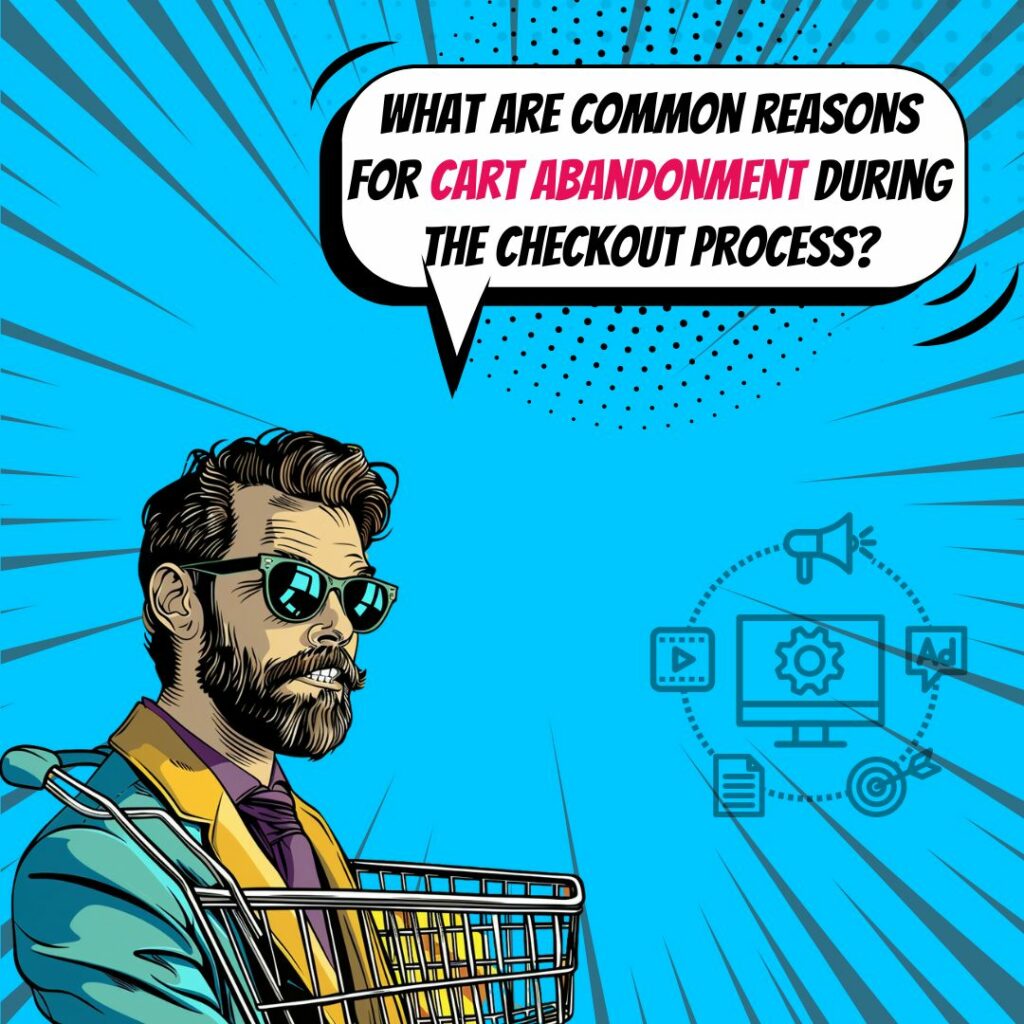Key Takeaways
✅ Simplify the Checkout Process: Did you know that a single second of delay in page response can result in a 7% reduction in conversions? Cutting down on the hassle could mean a significant boost to your sales. You can simplify the checkout process by testing and identifying problems from a customer's point of view, reducing the steps needed, and ensuring costs are clear from the get-go.
✅ Automate and Optimize: Surprising as it may sound, but about 24% of shoppers will abandon a cart if they can't see the total order cost upfront. By making sure discounts are applied automatically and showing progress clearly, you're respecting customer's time and budget, which in turn encourages them to complete their purchase.
✅ Enhance Trust and Convenience: It's estimated that 18% of users will abandon a purchase if they don't trust the site with their credit card information. Reinforce customer trust by incorporating testimonials, offering a variety of payment options, and supporting them with real-time help via live chat.

Introduction
Ever wondered why people fill up their online shopping carts only to leave them stranded at the checkout page? That's right, cart abandonment is a silent sales killer in the world of e-commerce. The truth is, a streamlined checkout process can make or break your online business. With e-commerce giants setting high standards, customers' expectations are sky-high.
The evidence is clear: a confusing or time-consuming checkout can send your potential customers straight to the arms of your competition. But how can you keep them on your site and turn those filled carts into completed sales? This article unpacks the art of simplifying the checkout process, from effortlessly applying discounts and promotions, to streamlining payment options, and building trust that your customers can count on.
What if you could not only retain your customers but entice them to come back for more? By enhancing user experience and offering that smooth, no-fuss payment, you're not just selling a product; you're providing a pleasant experience. And when it's about fine-tuning those last few steps, monitoring and optimizing comes into play. Isn't it time to bring out the big guns and ensure your checkout is nothing short of perfect?
Top Statistics
| Statistic | Insight |
|---|---|
| Cart Abandonment Rate: A significant high noted globally in 2024. | A spotlight on the growing e-commerce challenge, emphasizing the need for streamlined user experiences. |
| Additional Costs: 47% abandoned carts in the US due to unexpected costs. | Price transparency is key – customers dislike hidden fees that pop up late in the game. |
| Guest Checkout Option: Offering this can retain customers. | No account required means a faster checkout and potentially fewer abandoned carts. |
| Free Shipping: About 50% of small to medium businesses see increased sales with this offer. | Costs have a big impact – free shipping could tip the scales in favor of completing a purchase. |
| Security Measures: Over 80% of shoppers see a site as more secure with visible credit card logos. | Visual security cues are comforting – they help build the trust necessary for a customer to hit 'buy.' |
Simplifying the Checkout Process
When shopping online, customer experience is king, and a complicated checkout process is the court jester nobody invited. Have you ever tried to buy something online and given up because it was just too much hassle? You're not alone. Studies show that cart abandonment rates can be as high as 80%, and a complicated checkout process plays a significant role in that startling statistic. It's essential for retailers to identify areas of friction in their checkout flow by putting themselves in their customers' shoes. Reducing the number of steps to purchase and limiting the required information can make a big difference. Also, guiding customers with progress indicators, and avoiding surprises like hidden costs can help improve transparency and keep those potential customers on track to complete their purchase.
Automatically Applying Discounts and Promotions
Everyone loves a good deal, but what's better is not having to jump through hoops to get it. Automatically applying discounts and promotions at checkout is like giving customers a gift they didn't even know they wanted. It keeps them from missing out just because they didn't see the promo code buried in their email. Plus, by clearly showing the discounted prices right from the start, customers can feel like they're getting a bargain every step of the way. If that promo code pops up automatically at checkout, you've just removed a potential roadblock and paved a smoother path to sale completion.
Streamlining Payment Options
In this era of digital wallets and cryptocurrencies, offering only one way to pay is like telling your customers to walk barefoot when they own a pair of sneakers. Multiple payment options can cater to a wider audience, providing convenience and catering to personal preference. Implementing a guest checkout option can't be overstated—it's like leaving your doors open with a welcome sign. People value their time and often their privacy too, which means they might not want to set up an account for a one-time purchase. And when it comes to building trust, using respected payment processors like Amazon Pay or PayPal can be the equivalent of a firm and reassuring handshake.
Enhancing User Experience
A shopping cart should be like a loyal dog; easy to find and always within reach. It should be accessible across all devices. By incorporating a shopping cart slider, customers don't need to navigate away from their current page, keeping them focused on the prize - hitting that checkout button. And for those moments of hesitation or confusion? Implementing live chat support can be the guiding light for lost souls in the online shopping wilderness, providing real-time assistance to push them over the finish line.
Building Trust and Confidence
Did you know consumer trust can be as fragile as a house of cards in a mild breeze? Showcasing customer reviews and testimonials right at the point of purchase can fortify that trust. Transparency in shipping and return policies is also crucial. Nobody wants to buy a mystery box with unknown strings attached. And then there's security; displaying trust badges and seals is akin to having a burly bouncer at your store's entrance—it's all about instilling a sense of safety and care.
Monitoring and Optimizing
In the game of ecommerce, the rule is simple: always be improving. Tools like Airboxr help businesses keep an eye on their checkout success rates and the effectiveness of their latest tweaks. Regular A/B testing serves as a health check-up for the checkout experience, revealing which strategies lead to a clean bill of health and which need a prescription for change. Keeping a keen eye on how changes affect customer actions can unravel mysteries behind cart abandonment and pave the way to a more seamless buying process. Continuous refinement based on data-driven insights is the heartbeat of an effective checkout system, adjusting to the evolving preferences of the customer landscape.
AI Marketing Engineers Recommendation
Recommendation 1: Simplify the Checkout Process by Limiting the Number of Steps: Data consistently shows that complexity is the enemy of conversion. According to a Baymard Institute study, the average large-sized e-commerce site can gain a whopping 35.26% increase in conversion rate just by improving their checkout design. Minimizing the number of steps to check out can substantially reduce cart abandonment. Single-page checkouts are popular for their simplicity and speed—consider whether this could work for your business.
Recommendation 2: Introduce Guest Checkout Option to Expedite Purchases: Requiring customers to create an account before purchasing can be a major hurdle, leading to a drop-off in potential sales. Statistics reflect this: nearly 34% of potential buyers will abandon a shopping cart if forced to create an account. By offering a guest checkout option, you acknowledge and accommodate the needs of customers who seek a quick, no-strings-attached purchasing experience, encouraging them to complete their purchase without friction.
Recommendation 3: Implement Smart Payment Options Backed by Security Trustmarks: Modern consumers are looking for flexibility and security when it comes to payment. With the rise of digital wallets and contact on payment methods, implementing a variety of secure payment options such as Apple Pay, PayPal, and Google Pay could improve conversions. The presence of security trustmarks at the point of sale can reassure customers, potentially increasing completed transactions. According to a report from the Nielsen Norman Group, seeing familiar payment options and security certifications are among the top elements that enhance trust during checkout.
Relevant Links
- Mastering WeChat: Your Gateway to Chinese Digital Dominance
- Unlocking the Power of Douyin & Kuaishou: Short-Video Marketing Success
- Top SEO Techniques for Dominating South Korea's E-commerce Scene
- SEO Secrets for Topping Google.de: Visibility Unlocked
- Decoding Russia’s Social Media Revolution on VKontakte
Conclusion
In the landscape of e-commerce, few challenges are as persistent and costly as cart abandonment. Our journey through the steps to streamline the checkout process has revealed multifaceted strategies effective in tackling this issue. Simplifying the checkout process is not just about trimming down steps; it's about refining the user experience to encourage completion of a purchase. But what does it really take to convert hesitation into a sale?
It starts with walking in your customers' shoes, identifying and smoothing out any bumps they encounter along the way. By minimizing pages, limiting required information, and using progress indicators, we guide our customers clearly and swiftly towards the finish line. The importance of transparency cannot be overstated – hidden costs are the bane of confidence and a major contributor to cart abandonment.
Coupons and discounts can be a powerful lure, but when customers have to jump through hoops to use them, the appeal quickly fades. Automatically applying discounts keeps the momentum going strong and keeps your customers feeling valued and savvy. Providing a variety of payment options, including hassle-free guest checkout, is also critical for catering to a diverse and technology-driven clientele.
But it's not enough to just make the checkout process easier. You must also make your customers feel secure and supported. Integrating customer reviews, trust badges, and clear policies adds layers of reassurance that can turn the unsure shopper into a confident buyer. Lastly, what's improvement without measurement? Monitoring tools and A/B testing are essential for seeing what works and what doesn't, allowing us to continuously develop better shopping experiences. So, what's the bottom line? Streamlining your checkout process is a journey of endless improvement – one that requires commitment to listening, adapting, and optimizing. With these strategies in hand, are you ready to reduce cart abandonment and transform your checkout process into a seamless, reassuring, and customer-friendly experience?
FAQs
Question 1: What is the checkoutfs process in e-commerce?
Answer: The checkout process is that path folks take when they're online shopping and decide to buy something. It starts when they toss items into their virtual cart and doesn't end until they get that sweet confirmation that says, "Yep, it's yours!"
Question 2: Why is the checkout process important?
Answer: Why does it matter? Well, because it's the make-or-break moment for sales. Do it right, and you're turning browsers into buyers left and right. But if it's a mess, you might as well wave goodbye to those sales.
Question 3: How do I evaluate my current checkout process?
Answer: To check up on your checkout, take it for a spin yourself, listen to what your customers are saying, and dive into the numbers to spot where people are getting stuck or waving the white flag.
Question 4: What are common reasons for checkout abandonment?
Answer: Why do shoppers bail at checkout? Maybe they can't check out as a guest, they're spooked by no reviews, they get slapped with unexpected fees, have to jump through too many hoops, can't figure out shipping costs, get lost on the site, or were just kicking tires in the first place.
Question 5: How can I simplify the checkout process?
Answer: Want to keep it simple? Slash the number of forms, don't force folks to sign up, fill in what you can for them, and throw in something sweet like free shipping.
Question 6: Why is a mobile-first checkout process important?
Answer: Because these days, everyone's shopping with those little computers in their pockets. If your site isn't playing nice with mobile, you're not just losing sales, you're practically pushing customers away.
Question 7: How can I prevent shipping cost surprises?
Answer: No one likes a jump scare at checkout. Keep it calm by doing away with shipping fees, setting a spend limit for free shipping, or playing the loyalty card with a special club or membership.
Question 8: What are the benefits of offering multiple payment options?
Answer: More ways to pay? More happy customers. It smooths things out when customers can choose from options they trust and manage their money with – like digital wallets or flexible payment plans.
Question 9: How can I capture emails early in the checkout process?
Answer: Get those emails early by having a friendly pop-up, inviting folks to your newsletter, or other clever tricks. That way, you've got a second chance to say "Hey, still thinking about that cart?" if they walk away.
Question 10: Why is it important to keep the checkout page simple?
Answer: Keep it clean, keep it focused. Strip away anything that might turn heads away from crossing that finish line, like unnecessary navigation or flashy footers.
Academic References
- Ding, M., & Hua, Z. (2015). Optimal Checkout Strategies for Online Retailers. Production and Operations Management, 24(5), 726-744. This study investigates various checkout strategies from the perspectives of online retailers, revealing crucial factors that influence the checkout process and emphasizing strategies to build consumer trust and streamline information collection.
- Aguirre, E., Mahr, D., Grewal, D., de Ruyter, K., & Wetzels, M. (2015). Unraveling the Personalization Paradox: The Effect of Information Collection and Trust-Building Strategies on Online Advertisement Effectiveness. Journal of Retailing, 91(1), 34-49. The research in this paper addresses the paradox between personalization and privacy, providing valuable recommendations on how checkout strategies can collect customer information while also building trust to improve advertisement effectiveness.
- Bleier, A., & Eisenbeiss, M. (2015). The Importance of Trust for Personalized Online Advertising. Journal of Retailing, 91(3), 390-409. Through this study, the concept of trust is dissected in the context of personalized online advertising. Its findings can be translated into actionable insights for checkout processes, underlining the necessity for transparency and security measures to foster trust.
- Li, H., Sarathy, R., & Xu, H. (2011). An Extended Privacy Calculus Model for E-Commerce Transactions. Information Systems Research, 22(2), 259-274. This model extends the understanding of how privacy concerns can affect e-commerce transactions. The insights offer valuable guidance for checkout processes, aiming to effectively balance customer privacy concerns and the need for data collection.
- Martin, K. D., & Murphy, P. E. (2017). Overcoming Online Information Privacy Concerns: An Information-Processing Theory Approach. Journal of Business Ethics, 143(3), 517-534. This work presents approaches on how to address online users' concerns about information privacy, delivering strategies that can be adapted to checkout enhancements to encourage completion and minimize abandonment rates.












